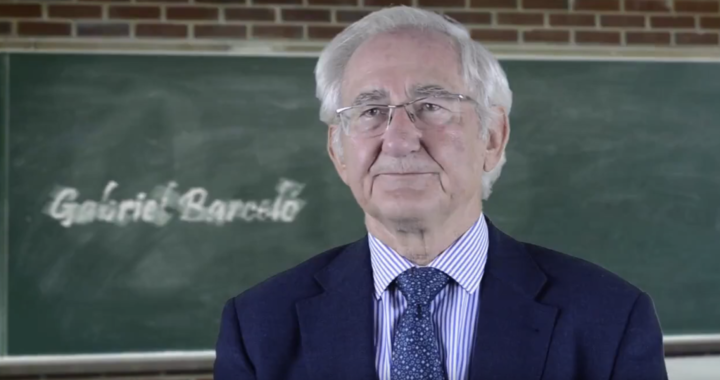Con posterioridad a la publicación en Amazon del segundo tomo del tratado NUEVO PARADIGMA EN FÍSICA, ha sido editado un texto divulgativo, explicando el contenido del tratado, y las causas y razones de haber realizado durante casi cuarenta años, un asombroso proyecto de investigación científica.

Ficha técnica
Título: Siempre es posible… un nuevo paradigma
Autores: Víctor Valencia y Gabriel Barceló
Editorial: Amazon Media EU, 2018
ISBN-13: 9781981081143
Páginas: 103
Dimensiones: 22.86cm. x 15.24cm. x 0.66cm.
Este libro es a la vez un testimonio y un manual. Recoge por un lado la odisea de un científico nato, ingeniero y físico de formación, Gabriel Barceló, que siendo todavía un niño descubrió indicios de un comportamiento inusual, y dedicó gran parte de su vida a deducir sus causas y sus leyes.
Por otro lado, el libro es también una clase sobre lo que es el emprendimiento aplicado a la investigación científica: sin tesón, sin metodología, sin sacrificio personal, sin conocimientos y habilidades específicas, no es posible llegar a la meta. Así lo explica el empresario y profesor Víctor Valencia.
El resultado es una obra sencilla, de fácil lectura, que nos introduce en el complejo mundo de las interacciones dinámicas y, al mismo tiempo, en el laberinto que permitió descubrir secretos olvidados de la Física.
Para Víctor Velasco, era importante difundir la constancia y tenacidad del equipo investigador, perseverando en esa búsqueda intelectual casi durante cuatro décadas, hasta llegar a publicar su legado científico: NUEVO PARADIGMA EN FÍSICA, por aplicación de un riguroso cumplimiento del método científico, y gracias a disponer de una meta concreta.
Este nuevo libro, SIEMPRE ES POSIBLE…UN NUEVO PARADIGMA, incorpora un prólogo y un epígrafe de Eduardo Martínez, que da coherencia a las exposiciones de los coautores.
Inicia el prólogo Eduardo con esta frase: Este libro es a la vez un testimonio y un manual. Recoge por un lado la odisea de un científico nato, ingeniero y físico de formación, que siendo todavía un niño descubrió una incógnita y dedicó gran parte de su vida a despejarla.
Los autores han realizado un esfuerzo para trasladar al lector no científico los resultados obtenidos en el proyecto de investigación científica privado español, que ha dado como resultado una inédita y novedosa Teoría de Interacciones Dinámicas.
La Teoría de las Interacciones Dinámicas propone un análisis específico de la fascinante historia del conocimiento humano del universo, y sugiere que la Teoría de la Relatividad debería ser revisada, así como ciertos conceptos de la astrofísica de cuerpos celestes en rotación.
Este libro cuenta cómo el investigador principal concibió y desarrolló esta brillante investigación a lo largo de su vida, y también explica los principios metodológicos del emprendimiento que hicieron posible su culminación. Son las dos caras de esta obra: ciencia y emprendimiento, la misma doble cara de la aventura humana.
Una vez leído el libro, uno llega a la conclusión de que es muy difícil romper esquemas en un entorno humano rígido que, a pesar de ser científico, y por ende presuntamente abierto a cualquier evolución del conocimiento, se resiste si quiera a considerar otras nuevas vías para la explicación de los fenómenos naturales.
El libro pretende compartir este esfuerzo personal con la sociedad, de poner a su alcance la riqueza de los descubrimientos conseguidos, y de sus potencialidades para mejorar la vida de las personas.
Sin que sea necesario que el lector esté previamente familiarizado con la dinámica rotacional, creemos que la lectura de este nuevo libro, permitirá conocer mejor la Mecánica Celeste, y el porqué de que los cuerpos en el universo, orbitan, pero también rotan sobre un eje.
Estamos convencidos que esta nueva visión del universo, original e inédita, que se propone en el tratado NUEVO PARADIGMA EN FÍSICA, y que se trascribe en este nuevo libro de forma simplificada, y sin formulaciones ni ecuaciones, permitirá a muchos no especialistas, el conocer mejor el comportamiento del cosmos y de la propia naturaleza.
Además, en este texto, se intenta combinar la ciencia con el emprendimiento, describiendo también las causas que permitieron desarrollar el proyecto de investigación científico, y que inspiraron la Teoría de Interacciones Dinámicas.
Víctor Valencia propone simultáneamente en este libro, una visión empresarial del proyecto de investigación científica realizado, e insinúa ciertas claves que permiten una mejor comprensión del proceso innovador.
Convierte así al libro, en un texto sobre lo que es el emprendimiento, incluso en el supuesto de un proyecto de investigación científica, sugiriendo que sin tesón, sin metodología, sin sacrificio personal, sin conocimientos y sin habilidades específicas, no es posible llegar al objetivo empresarial deseado.
Es una obra sencilla, de fácil lectura, que nos introduce en el complejo mundo de una nueva física cuyos secretos parecían estar todavía olvidados, pero también, y gracias a la pluma de Víctor Valencia, en los principios metodológicos del emprendimiento, y en la importancia, en toda empresa humana, de las interacciones humanas y empresariales. Estos son los dos aspectos de esta obra: ciencia y emprendimiento, como siempre ocurre en la aventura humana.
Puede consultar los siguientes videos sobre el contenido del tratado:
https://www.youtube.com/watch?v=MRq7EclUsbA
https://www.youtube.com/watch?v=tTLDvLUdgro
https://www.youtube.com/watch?v=xCDEIbo89Ps
https://www.youtube.com/watch?v=QYcT8OlqzEU
Para mayor información pueden consultarse los siguientes portales:
https://www.tendencias21.net/libros/Siempre-es-posible-Un-nuevo-paradigma_a670.html
https://newparadigminphysics.com/es/inicio/
https://advanceddynamics.net/
http://dinamicafundacion.com/
http://www.tendencias21.net/fisica/




